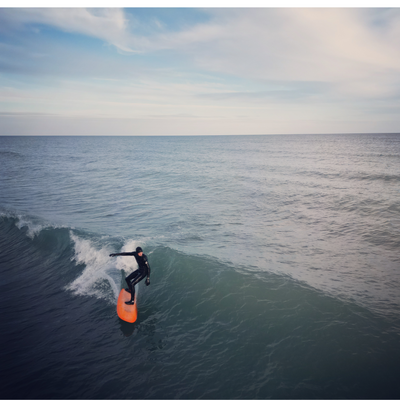Wetsuit Guide:
The Great Lakes are a unique surfing experience, freshwater and usually colder water temps. An example is mid June where airtemps are 70/80 degrees but the lake can be under 50 degrees. Dress for the water not the air! Winds play a big factor...we need winds to create our waves but not having wind when surfing is more ideal, finding clean waves is the trick! This is an example of temps in the lakes and if al else fails go thicker!
|
Water Temperature Range (°F) |
Wetsuit Thickness |
Recommended Wetsuit Type |
Seal Type |
|
>72° |
N/A |
Rashgaurd |
N/A |
|
65°- 75° |
.5 mm - 2/1 mm |
Top / Shorty |
N/A |
|
62°- 68° |
2 mm - 3/2 mm |
Spring Suit / Full Suit |
Flatlock |
|
55°- 63° |
3/2 mm - 4/3 mm |
Full Suit + Boots |
Sealed |
|
46°- 56° |
4/3 mm - 5/4/3 mm |
Full Suit + Boots + Gloves + Hood |
Sealed and Taped |
|
37°- 47° |
5/4 mm - 5/4/3 mm |
Full Suit + Boots + Gloves + Hood |
Sealed and Taped |
|
38° and below |
6/5 mm - |
Full Suit + Boots + Gloves + Hood |
Sealed and Taped |
When choosing a suit be sure to not only take water temperature into account, also consider:
- Air Temperature
- Wind Speed
- Personal Sensitivity to Cold
It’s Important to consider that for colder air, higher winds, and an activity that results in less movement, a thicker suit may be something to consider. These are not concrete guidelines but just general recommendations. Many brands provide their own lists containing slightly different numbers.
How Does a Wetsuit Work?
A wetsuit is a neoprene suit used in watersports that works by trapping a thin layer of water in the suit and allowing your body heat to warm the water up. It allows you to stay warm in cold water and not lose too much of your body heat.
Wetsuits are not meant to keep you totally dry but rather they let in a small amount of water and trap heat in. This means that the thicker a suit is, the warmer you’ll be in the water. Because of this, it’s important to research the water temperature for the area you will use your wetsuit the most. If the water gets cold enough that the rest of your body may become numb, it’s crucial that you go out with boots, gloves, and a hood.
Wetsuit Thickness
Wetsuit thickness is one of the most important aspects of the suit. The thickness can help you gauge how warm you will be in the water. The thickness is measured in millimeters (mm), represented by two or three numbers written with a slash between them. (Ex. 5/4 mm or 5/4/3 mm) The first number represents the thickness of the neoprene in the chest region. The second number represents the thickness of the arms & legs. (Just the legs if a third number is present) and the last number, if present, represents the thickness in the arms. The thickest part of the wetsuit is the chest area (first number) and is used to maintain your core body heat, which is crucial to prevent hypothermia. The second and third numbers are used for extremities and while you’d think you’d want them all to match but this would result in less mobility. So, the thicker neoprene is placed where you need minimal movement while the thinner neoprene is placed in high movement areas. (Legs & arms)
How Should a Wetsuit Fit?
Fit is extremely important when it comes to wetsuits. It should fit like a second layer of skin and be tight. You don’t want it cutting off circulation or being painful but it's crucial that it fits tight. If it’s baggy and loose then it’s more likely water will flush into your wetsuit and make the suit ineffective in keeping you warm. When it comes to suits it is best to consult brand specific size charts since size varies from company to company.
Some important takeaways on how a suit should fit are:
- After you put your wetsuit on there should be no extra room in the chest, crotch, shoulders, or knees. A proper fitting wetsuit will be challenging to put on.
- Once the suit is on, put your hands over your head and stretch your shoulders. There should be a slight restriction but if it’s painful or too restrictive then the suit is too small.
- You should be able to squat down and move your arms easily (wetsuits above 5/4mm are inherently restrictive).
Types of Wetsuit Zippers
Back Zip Wetsuits
This is the classic solution with the zipper going down the length of the spine with a long cord attached so you can zip yourself in and out. The advantage of a back zip is that, relative to the other styles, it is typically the easiest to enter and exit. This is a big deal when you are trying to get into something that is skin tight. The disadvantage is that water can get through the seams on the back zip, which in cold water can become a major deterrent (think ice cubes down your back). Many companies have come up with their own flush guard technologies to reduce this from happening. Also, when you are bending forward, the suit will go taut in the back and the zipper lacks give, which may restrict movement.
Chest Zip Wetsuits
Chest zip wetsuits are entered through a zippered cutout around the neck and you drop down into the suit through the neckline before pulling the neck cut over your head and zipping closed at the chest. Chest zips are the trickier of the two types to both enter and exit. The chest zip is superior at keeping water from penetrating the suit through the seams and the neckline. The chest zip may also be a more comfortable fit once on with a snug neck that is less likely to cause rashes and the zipperless back yields a greater level of flexibility.
Zipperless Wetsuits
Found on lighterweight (think 3/2 and thinner) wetsuits and neoprene tops, these suits prioritize mobility over warmth by eliminating the lack of flex found around zippered areas and stitching. This may be a good solution if you have issues with mobility while paddling or surfing. The entry point for zipperless wetsuits can be found around the chest or neck area and is usually secured by a small zipper, elastic or velcro.

